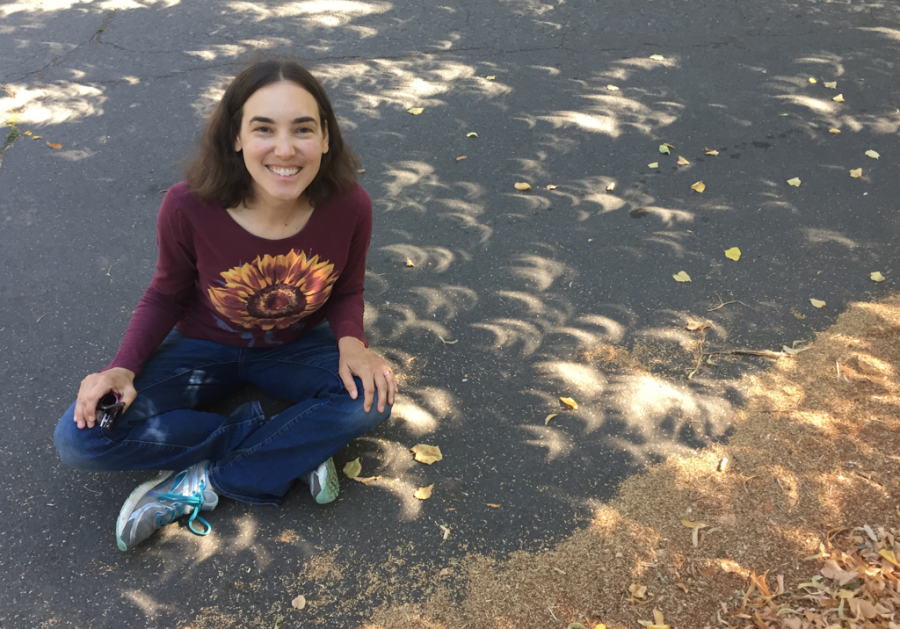Reach for the (Double) Stars
OHS students have a long history of looking to the stars. Recently, groups of students have been doing research on double stars in a series of independent projects leading up to the newly offered Astronomy Research Seminar course starting this Spring at the OHS.
Kalee Tock, an instructor at OHS, has been leading these projects. Ms. Tock teaches Foundations in Science, and has also at various times taught Astronomy, Inquiry-Based Physics and Honors Chemistry. She has, however, had an interest in astronomy from an early age. “One of the reasons I like astronomy is that it’s so interdisciplinary,” she claims.
Ms. Tock got inspiration to perform research on double stars from Rachel Freed, a former Chemistry instructor at OHS, who introduced Ms. Tock to Russ Ginet, an astronomer who was doing an astronomy research seminar of his own. Ms. Tock was hooked. She readily admits that she didn’t have much experience. “I didn’t even know what double stars were, really,” she laughed, “But now I do.”
At first, Ms. Tock recruited a number of OHS teachers and one student to blindly see what they could learn about double stars, which are stars that may or may not be orbiting each other.
It was not smooth sailing at first. At one point, based on the advice of a professional that Ms. Tock got in touch with, they decided that they had to redo all of the statistical analysis that they had done (this later motivated the person who created the software they were using to review it). In fact, this first project took almost a year, since they were constantly modifying the procedure. Nonetheless, they finally got adequate data, and they learned a lot in the process.
Concurrently, Ms. Tock started a second spring pilot with several OHS students. They plotted observations of a proposed set of double stars. This process took only a few months, since Ms. Tock was more familiar with the process. Hagan Hensley, one of the students involved, found that “by plotting all the locations of the secondary star relative to the primary over time from past observations, of which there were dozens, including ours, we were able to get an idea of the nature of the motion of the secondary star relative to the primary. We found that the specific stars we chose weren’t actually orbiting, but just happened to be lined up from our perspective.”
Ava Giles, who was also involved in the spring pilot, presented these findings at a conference in San Diego. A paper written by herself and Hagan will appear in the Journal of Double Star Observations in January.

A third project with a number of other OHS students is currently ongoing. This group is studying a specific type of double stars: eclipsing binaries. These are stars that are orbiting that you can observe through dips in the light curves when they pass in front of one another. Ms. Tock isn’t sure about the timeline of this project.
The results don’t come easily. Hagan described one of the issues they faced: “Later, we were trying to look more closely at some of the past observations, specifically the one from 1835 made by famous astronomer Sir John Herschel. We searched through his catalog for a match to our star and couldn’t find one. Eventually we realized he was using a different coordinate system for specifying the locations of the stars, and so that’s why we couldn’t find a match. All too late, we realized Herschel’s catalog number was actually available right on top of the list of past observations for our star, and we could have found it easily if we had noticed.”
Ms. Tock notes that this is indicative of real science. “In the process, a lot of the stuff that happened was sort of what happened in science,” she asserted, “it’s messy. It’s always messy.” Describing her classes, she recounts. “Students will often come to me and say that it didn’t work and my response is that ‘No, the science always works. It might not have done what you expected, but that’s where the fun starts.’” These projects are certainly not guaranteed an answer, but that’s a signature part of the appeal. Ms. Tock says that a trigonometry background is helpful in approaching these problems, but, she says quoting Russ Ginet, “Research teams need lots of different kinds of contributions.” She encourages everyone to give it a try, no matter your interests.
As for Hagan, he was enthusiastic about where the projects would lead him. “This was my first real experience with scientific research, culminating in publishing a paper,” he said, “More than anything else, I learned how much I love the process of research. In fact, I decided to continue the project on my own time during the summer, coming up with a way to determine the exact parameters of a binary star’s orbit, and I’ve sent off another paper for publication in the same journal. The project really got me hooked.” Check out Ms. Tock’s second semester course and it may get you hooked too.

